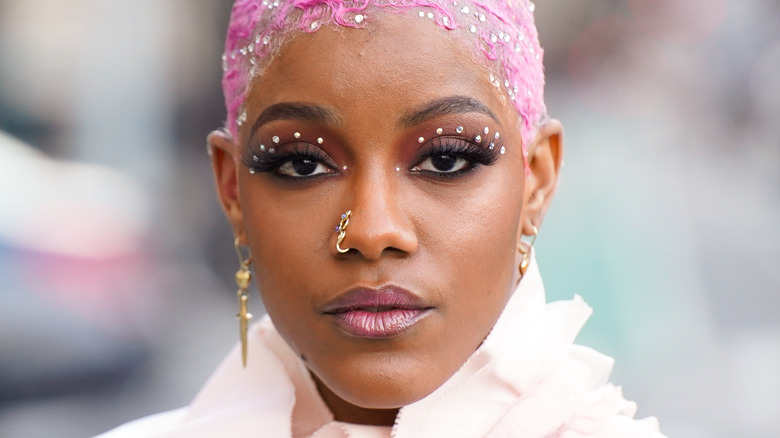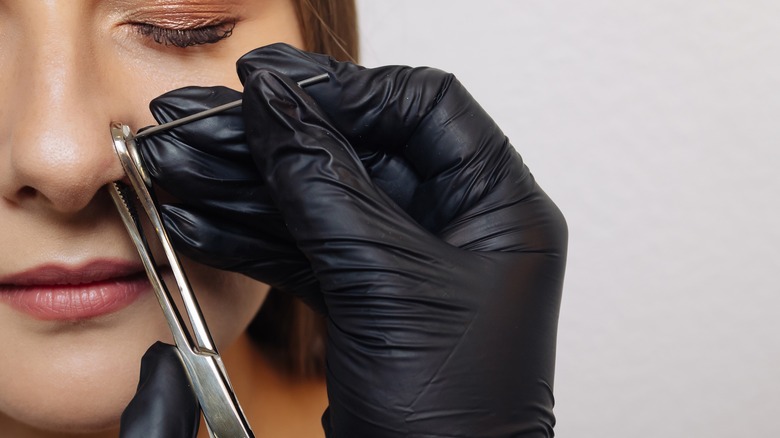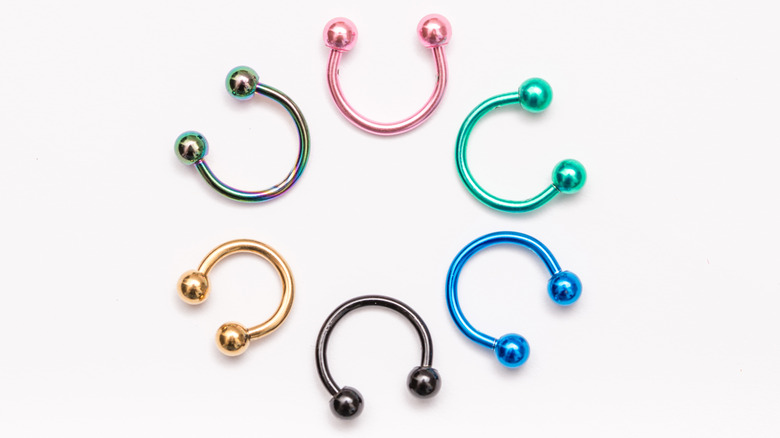Here's How To Clean Your New Nose Piercing
If you just got a new nose piercing or are thinking about getting one, know that proper aftercare is a must. These stylish accessories can be done on the skin around the nostrils (the nares), the cartilage between your nostrils (the septum), and below the septum just under the cartilage (via WebMD). However, doctors consider the nose to be the "danger triangle" of your face. The veins in this area are connected to the sinus cavity, so this area is at risk of infection after a piercing.
Regardless of where your nose piercing is, it's important to have a licensed professional do it with sterile equipment, such as a needle over a piercing gun. Blood, swelling, bruising, or tenderness are normal when you first get your piercing. You should also know that it can take up to four months to heal depending on where it's placed; therefore, it's important to clean your piercing and look after it carefully at home (via WebMD).
Cleaning and caring for your piercing
First and foremost, when it comes to having any contact with your piercing, make sure you wash your hands. Hands carry bacteria, and the nose is already a sensitive area for bacterial infections. Rachel Nazarian, M.D., a board-certified dermatologist, tells Byrdie that "the nose is filled with a high volume of bacteria, and infections are common in this area, so don't manipulate the piercing within the first two to three weeks." Nazarian recommends using a saline or salt water wash twice a day inside and outside of the piercing area.
Many piercers will also recommend the saline wash, stating that it should be done in the morning and at night. When caring for your piercing, you also have to be careful that you're not doing it too much. "Healing isn't something that can be rushed, and overcleaning can actually lead to irritation and a longer healing process," Ava Lorusso, a professional piercer, tells Cosmopolitan. Lorusso warns that anyone with a fresh piercing should keep an eye out for bumps and signs of infections.
Sometimes, aftercare may involve dealing with an allergy rather than an infection. Jewelry can be made from many different metals, some of which could cause an allergic reaction on your skin. Signs of this are itchy skin, swelling, or the development of hives shortly after receiving the piercing. If this happens, professionals at Chronic Ink Tattoo recommend removing the jewelry immediately and possibly treating it with antihistamines. They also suggest checking in with your doctor to run allergy tests.
What to avoid during the healing process
With any piercing or open wound comes a set of safety precautions to take during the healing process. While it's tempting to take matters into your own hands, it's imperative that you stick to the basics of the aftercare routine recommended by your piercer. According to Healthline, you should never use over-the-counter products such as Neosporin or hydrogen peroxide. Meanwhile, if you have suspicions of infection, check in with your piercer. Additionally, do not touch, move, or twist the piercing around because it can lead to irritation.
Even during the cleaning process, the jewelry must stay in place. This means that it cannot be swapped out for a different style of jewelry. For example, you cannot switch your stud for a hoop until the piercing site is fully healed (via Byrdie). If you're ever unsure about what next step to take, always ask your piercer or a doctor for their professional guidance. Trust us: they want you to be safe and won't feel bothered if you ask.


